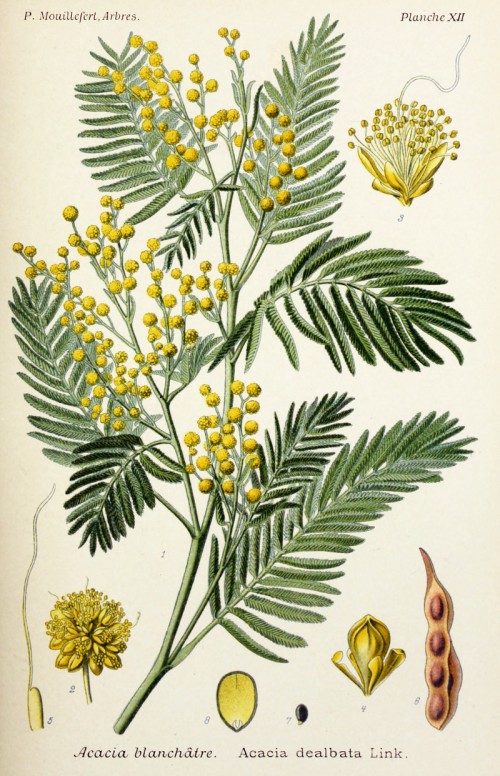Dies ist eine alte Version des Dokuments!
Acacia dealbata Link - syn.Acacia decurrens var. dealbata (Link) F.Muell.; Racosperma dealbatum (Link) Pedley - Fabaceae
silver wattle, Silberakazie, Mimose
Shrub or tree,native to Australia, naturalized and cultivated elsewhere; leaves argenteous to greenish, pinnae 10-20, leaflets 26-46 pairs, dense, linear; flowers yellowish or yellow-orange.; legume red-brown or black, glaucous, oblong, flat, 3-8cm long.
http://www.efloras.org/florataxon.aspx?flora_id=2&taxon_id=200011849
Mimosa absolute has the viscosity of mobile Sirup and owns a sweet powdery, floral note with a honeyed fresh cut grass undertone, dry down reveals violet-like heart note.
„There are several species in the botanical family Acacia that produce fragrant flowers. Just two species, Acacia decurrens and A. farnesiana, have uses in perfumery. A. decurrens is appropriately referred to as Mimosa and A. farnesiana as Cassie syn. Sweet Cassie, and not to be confused with Cassia. “
http://www.lgbotanicals.com/Mimosa-Absolute_p_732.html
„Since decades mimosa (Acacia dealbata) absolute oil has been used in the flavor and perfume industry. Today, it finds an application in over 80 perfumes, and its worldwide industrial production is estimated five tons per year. Here we report on the chemical composition of French mimosa absolute oil. Straight-chain analogues from C6 to C26 with different functional groups (hydrocarbons, esters, aldehydes, diethyl acetals, alcohols, and ketones) were identified in the volatile fraction. Most of them are long-chain molecules: (Z)-heptadec-8-ene, heptadecane, nonadecane, and palmitic acid are the most abundant, and constituents such as 2-phenethyl alcohol, methyl anisate, and ethyl palmitate are present in smaller amounts. The heavier constituents were mainly triterpenoids such as lupenone and lupeol, which were identified as two of the main components. (Z)-Heptadec-8-ene, lupenone, and lupeol were quantified by GC−MS in SIM mode using external standards and represents 6%, 20%, and 7.8% (w/w) of the absolute oil. Moreover, odorant compounds were extracted by SPME and analyzed by GC-sniffing leading to the perception of 57 odorant zones, of which 37 compounds were identified by their odorant description, mass spectrum, retention index, and injection of the reference compound.“
[Chemical composition of French mimosa absolute oil., Perriot, R., Breme, K., Meierhenrich, U.J., Carenini, E., Ferrando, G., Baldovini, N., Journal of agricultural and food chemistry, Vol.58(3), 2010, 1844-1849]

Mouillefert, P., Traité des arbres et arbrissaux, Atlas, t.12 (1892-1898)
http://plantgenera.org/species.php?id_species=1255939
